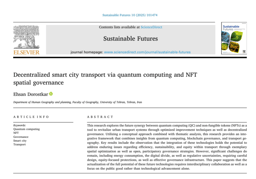Quantum-Secured NFTs: Tools for Urban Liberation or Corporate Domination?
Published in Social Sciences and Earth & Environment

Our cities stand at a digital crossroads. Technologies like blockchain and non-fungible tokens (NFTs) promise more transparent management of urban resources from housing to public parks. Yet the rise of quantum computing threatens to shatter today’s digital foundations by cracking classical cryptography.
My new article, “Beyond solutionism: quantum-secured NFTs as contested infrastructures for radical urban futures” in Local Environment, tackles a critical question: Can quantum-secured NFTs truly foster fairer, sustainable cities or will they become tools for entrenching inequality and corporate power?
The Emancipatory Promise
-
Quantum-Resistant Security: Algorithms like lattice-based cryptography (e.g., CRYSTALS-KYBER) could shield critical urban infrastructure (land registries, voting systems, public assets) from future quantum attacks.
-
Reclaiming the Commons: NFTs could enable radical collective governance models:
-
Fractional NFT deeds for community-led affordable housing cooperatives.
-
Anti-eviction smart contracts protecting marginalized residents.
-
Decentralized Autonomous Organizations (DAOs) managing parks or energy grids, with voting power tied to residency not wealth.
-
The Inevitable Pitfalls: Lessons from History
Past “revolutionary” urban tech reveals sobering patterns:
-
Sharing Economy Fallout: Uber and Airbnb promised empowerment but became engines of wealth extraction, worsening housing crises.
-
Blockchain’s Broken Vows: Land-titling projects (e.g., Bogotá) excluded those without digital access and failed to disrupt power imbalances.
-
Corporate Smart Cities: Ventures like Toronto’s Sidewalk Labs prioritized data extraction over community needs until public resistance halted them.
Quantum NFTs risk repeating these failures through:
-
Corporate Capture: Tech giants control development, aligning tools with profit not justice.
-
Deepened Divides: If quantum infrastructure (e.g., computing centers) only serves elites, we risk “quantum gentrification.”
-
Energy Blindspots: Current blockchains consume massive energy; quantum-NFTs demand sustainable design.
A Justice-Centered Pathway
The liberatory potential of quantum NFTs is conditional. They must:
-
Be Designed by Movements: Housing justice coalitions, climate resilience groups, and informal settlement communities should lead development (e.g., Barcelona’s digital sovereignty experiments).
-
Function as Public Goods: Require public quantum computing centers in marginalized neighborhoods and open-source platforms not proprietary systems.
-
Prioritize Policy Safeguards:
-
“Quantum equity ordinances” mandating NFT deployments alongside public quantum access.
-
Real-time energy disclosure tied to sustainability goals.
-
-
Reject Tech Solutionism: Sometimes, the most just choice is rejecting the tech entirely to protect proven community governance models.
The Pivotal Question for Urban Futures
The fate of quantum NFTs isn’t predetermined. We must ask not “How do we implement this fairly?” but “Should we implement this at all?” And if so:
How do we weaponize quantum NFTs for liberation?
Could they enforce reparative zoning? Could land NFTs expire unless equity targets are met?
Join the Discussion
What do you think?
-
Can quantum-secured NFTs become tools for equitable cities?
-
What lessons from past tech failures should shape their design?
-
When should cities reject new technologies to protect community sovereignty?
Read the full analysis here:
Dorostkar, E. (2025). Beyond solutionism: quantum-secured NFTs as contested infrastructures for radical urban futures. Local Environment. DOI: 10.1080/13549839.2025.2519367**
Follow our research on Twitter | LinkedIn






Please sign in or register for FREE
If you are a registered user on Research Communities by Springer Nature, please sign in